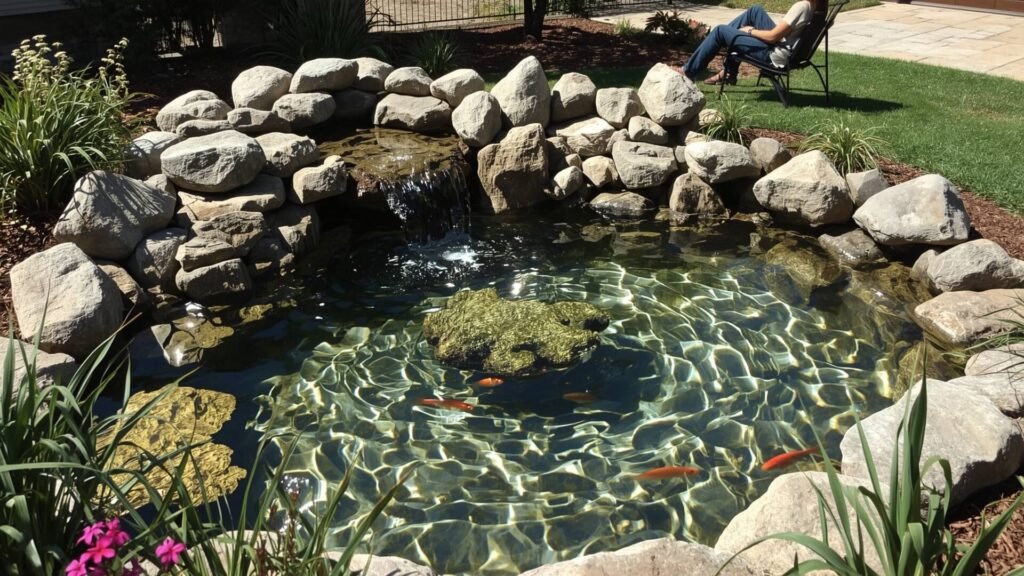
Building a fishpond in the backyard is a rewarding project that turns any outdoor space into a peaceful haven. To build a fishpond, a person needs to plan the layout, dig the hole, line it, install a pump, and add the right plants and fish. This process is easy to follow with the right approach, and it offers a beautiful spot to watch nature up close.
Anyone interested in ponds can use simple tools and everyday materials to get started. Deep ponds, usually 3 to 5 feet, work best for keeping fish healthy and water clean. Using pumps, filters, and aquatic plants keeps the environment safe and attractive for fish all year round. Clear steps and careful choices make the process smooth and rewarding, no matter the size or style of the pond.
Key Takeaways
- Careful planning and design help create a successful fishpond.
- Filters and plants are important for clean water and fish health.
- Regular care is needed to manage water and keep the pond beautiful.
Planning How to build a Fishpond
Proper planning helps prevent costly mistakes when building a fishpond. The main steps include deciding the pond’s purpose, picking the right location, and understanding local laws and environmental impact.
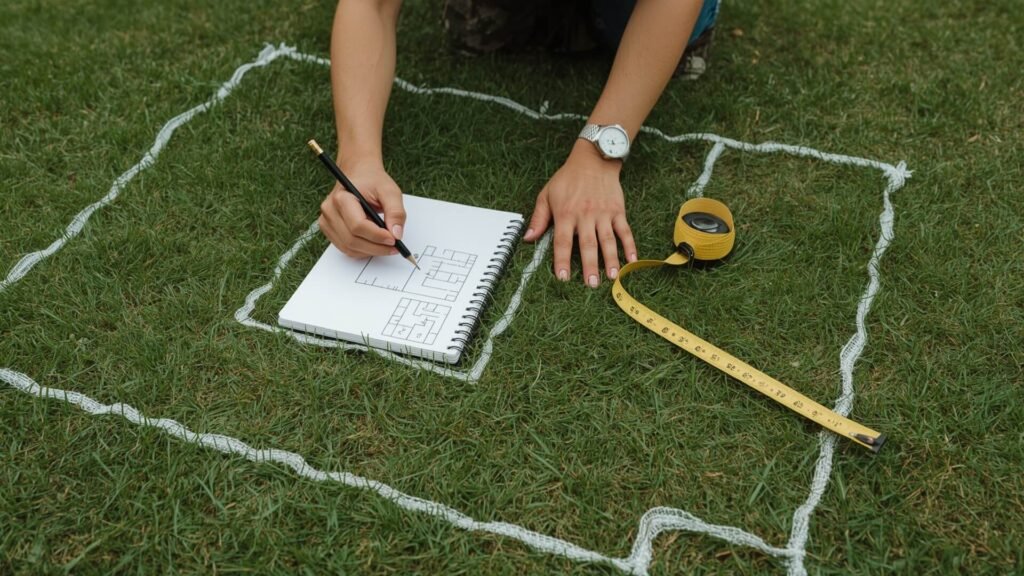
Setting Goals and Objectives
Defining clear goals is the first step. Some people want a pond mainly for fish like koi or goldfish. Others want it as a water feature with plants and a small fountain. Knowing the primary use guides other choices such as pond size, depth, and equipment.
He or she should consider if the pond will serve as a calm place to relax, support certain fish, or attract wildlife. Make a list of must-haves versus nice-to-haves. For example, if someone wants to keep fish, the pond should be at least 4 feet deep to protect them from temperature changes and predators.
Other important objectives may include easy maintenance or adding lighting for nighttime enjoyment. Having these goals in mind helps keep the project on track and under budget.
Choosing the Ideal Location
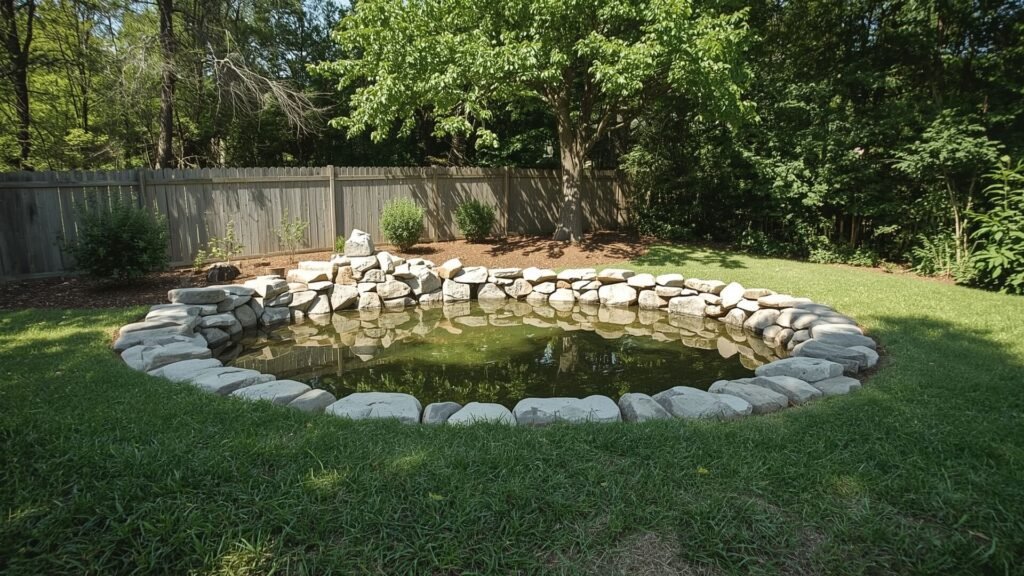
Picking the right spot in the yard is important for pond health and maintenance. A pond needs some sunlight, but too much can lead to algae growth and hot water. Aim for a location that gets about 4-6 hours of sunlight each day.
Avoid low areas where rainwater can carry chemicals or debris into the pond. Do not place the pond right under trees, as falling leaves add extra cleanup and can clog filters. Close access to water and electricity make things easier for pumps, filters, and other equipment.
Space matters. Leave room around the edges for planting or walking. Use a straight plank and spirit level to make sure the ground is even across the pond’s area.
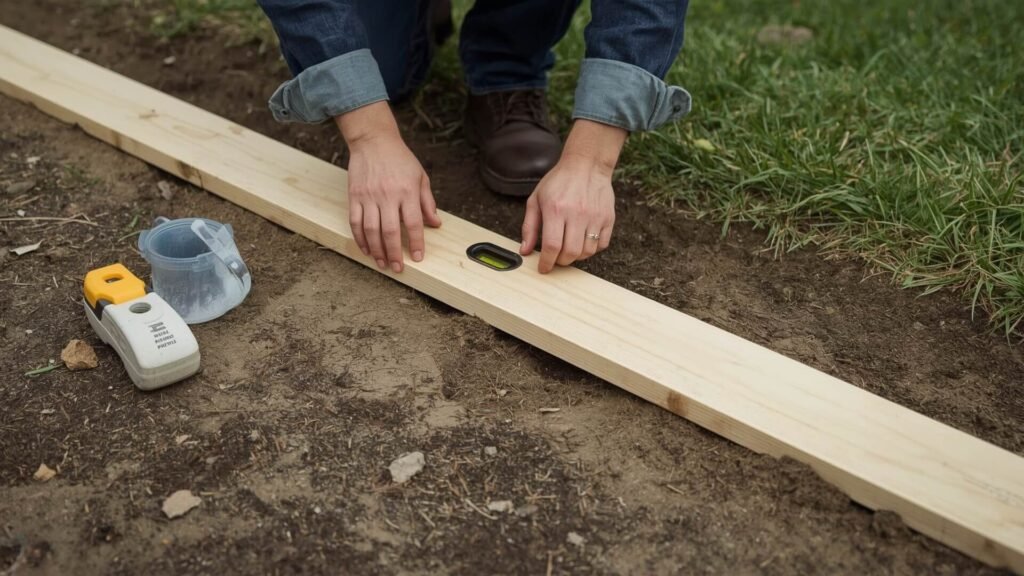
Visit this step-by-step pond building guide for extra help picking an ideal spot.
Legal and Environmental Considerations

Check local zoning rules and codes before digging. Some places require permits even for small backyard ponds. Rules may control pond depth, fencing, or distance from buildings. A quick call to the local town office avoids trouble later.
Respect the environment by making sure the pond will not disturb natural waterways or protected wildlife areas. Prevent overflow or leaks from sending pond water into sewers or creeks, which may be against regulations. Avoid adding non-native plants or fish that could harm local habitats.
In some areas, home insurance policies may also need an update when a pond is added. It is smart to ask before construction starts. For more detailed planning steps and legal tips, see this fish pond planning resource.
Designing the Fishpond
Every detail in fishpond design affects water quality, pond stability, and the comfort of the fish. The planning stage will decide the pond’s looks, as well as how easy it is to maintain and enjoy.
Determining Pond Size and Shape
The size and shape of a fishpond depend on space, budget, and the type of fish planned for the pond. Koi and larger species need more room, often requiring ponds at least 1,000 gallons. For goldfish or smaller fish, a pond as small as 300 gallons is suitable.
Pond shapes can be rectangular, circular, or more natural and freeform.
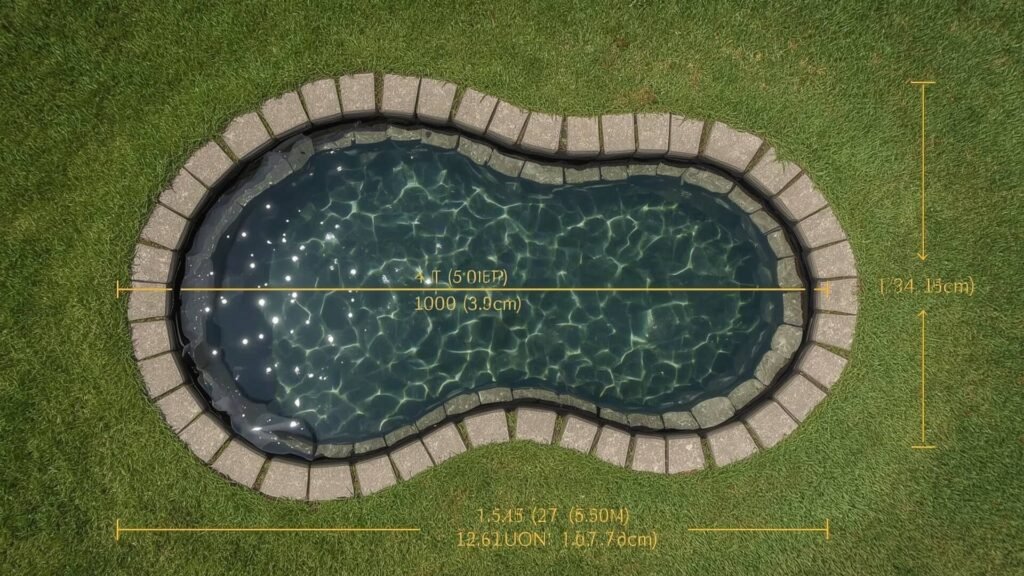
A freeform style can help the pond blend in with the garden. Measure the area using rope or a garden hose to lay out the outline before digging starts.
Consider access for cleaning or repairs. Ensure there are no sharp corners, as these can trap debris and stress the fish.
| Pond shape | Pros | Cons |
|---|---|---|
| Circular | Easy to clean, simple look | Less natural looking |
| Rectangular | Good for formal gardens | Sharp corners |
| Freeform | Blends with landscape | Harder to plan |
Selecting Materials and Liners
Choosing the right liner is key to stopping leaks and protecting fish from harmful chemicals. Rubber liners, such as EPDM, are flexible and safe for fish. They can be shaped to fit most designs and last for many years with little trouble.
Preformed plastic liners are stronger but less flexible. They come in set shapes and sizes, which may limit design options. Concrete is another option for permanent ponds, but it costs more and needs sealing to make it safe for fish.
When comparing options, EPDM rubber liners are popular for their balance of cost, ease of use, and durability. Always use liners and materials labeled as safe for aquatic life to avoid harming fish or plants.
Pond Depth and Shelving
Pond depth affects the health of fish and water quality, especially in areas with extreme temperatures. For most fish, the pond should be at least 2 feet deep. If the pond will hold koi, a depth closer to 3-4 feet helps protect them from predators and helps water stay cool in summer and unfrozen in winter. For reference, a deep pond also helps keep water temperatures stable, reducing stress for the fish (see more details on recommended pond depth at wikiHow on backyard fish ponds).
Shelves or step-like ledges should be built around the edge of the pond. These support plants and create places for fish to hide. Design shelves at different depths, such as 6-12 inches for marginal water plants and 18 inches or more for deeper plants and fish hiding spots.
Using varied depths can also improve the look of the pond and support a wider range of plant and animal life. Sloped sides are better than steep drops, as they help wildlife enter and leave the pond safely.
Excavation and Construction
Building a fishpond takes careful planning and smart work during construction. The main steps include preparing the site, digging the pond basin, and adding strong, attractive borders. Attention to detail at each stage helps prevent leaks and creates a long-lasting pond.
Site Preparation
Proper site preparation begins with clearing all grass, weeds, and debris from the area. Workers should remove any large rocks, stumps, or roots that could damage the liner or interfere with the pond’s shape. It is important to check for underground utilities or pipes before digging.
A soil test is needed to confirm the ground will hold water. Soils high in sand or gravel do not seal well and can let water escape. Areas with heavy clay or loam are best. For advice, see guidelines on appropriate soils for ponds. Mark out the pond shape with spray paint or a garden hose to guide excavation. Double-check the location is not too close to trees, which can drop leaves and roots into the water.
Excavating the Pond Basin
The depth and size of the basin should match the type of fish and climate. Most backyard fishponds need to be at least 24 inches deep to keep fish safe and healthy, with greater depths needed in cold areas to protect from freezing temperatures. Shape the bottom with slopes rather than steep walls to prevent collapse.
Dig in sections, removing soil carefully. Pile the soil away from the work area. As each level is reached, smooth it out and check it is level and even. Add gentle ledges along the sides to create shelves for plants and to offer shallow zones for fish to feed and shelter. Using a level and a long board, check the pond’s edges are flat and at the same height all around, so water will not spill out unevenly. For guidance on proper pond depth and excavation, use established standards.
Installing Edging and Borders
Once digging is finished, strong edging materials help keep the pond walls stable and the liner secure. Choices for edging include stones, bricks, pavers, or specially made pond edging products. It is best to use heavy, flat stones to weigh down the liner and prevent it from shifting or blowing away.
Lay the liner in the pond, smoothing out wrinkles. Extend it past the pond edge by at least 12 inches. Trim after placing the first row of edging. Place stones or pavers along the rim, overlapping the liner by a few inches. Press each piece firmly into soil and adjust as needed to create an even, attractive border.
Edging also helps hold back grass and dirt, which keeps the pond water cleaner. Choose materials that match the garden style and that can withstand weather without breaking down. If needed, a thin layer of sand can be added under the liner for extra protection. Consistent, secure edging adds the finishing touch and supports the pond structure for years.
Setting Up Filtration and Aeration
Filtration and aeration are essential for clean water and healthy fish. Good systems remove debris, circulate water, and add oxygen, all of which help support aquatic life.
Choosing Filters and Pumps
Filters keep pond water clear by trapping dirt, fish waste, and other particles. There are different types of filters, such as biological and mechanical. Biological filters break down waste using bacteria, while mechanical filters physically remove particles. For a simple and effective DIY setup, a lidded garbage bin can be turned into a filter using filter mats and a water pump that fits your pond’s size and fish load.
Pumps are important for moving water through the filter. A pump should match the pond’s volume—usually, it should move all the pond water at least once every hour. For example, a pump rated at 6100 GPH (gallons per hour) is suitable for larger ponds. Make sure all hoses and connections are tight to prevent leaks. To see a step-by-step DIY filter build, visit this guide on building your own pond filter system. Choosing a pond pump shouldn’t be a hassle. We’ve broken down the options to help you find the right one—fast.Check here to find out which one suits your needs.
Installing Aeration Systems
Aeration adds oxygen to the water, which is important for the health of fish and helpful bacteria. Common types of aeration systems for ponds include air pumps with diffusers, small fountains, or waterfall features. An aerator should be placed in a spot where it can move water throughout the pond, but not blow debris directly at the filter intake.
Adding aeration also mixes the water, which helps even out the temperature and prevent “dead zones” without oxygen. These systems are especially important in warmer months when fish use more oxygen. For detailed instructions, check this step-by-step guide to installing a pond aerator.
UV Sterilizers and Water Treatments
A UV sterilizer uses ultraviolet light to kill algae and harmful microorganisms as water passes through the unit. This reduces green water caused by algae blooms and helps keep the pond clear. UV sterilizers are placed inline with the filtration system, after the pump and before the water returns to the pond.
Besides UV sterilizers, some ponds need special water treatments to control algae or balance pH. Treatments should always be chosen carefully to protect fish and plants. Always follow the product instructions, and avoid over-treating to prevent sudden changes in water chemistry. Planning proper filtration along with UV light will lead to cleaner and safer pond water.
Managing Water Quality
Good water quality is the backbone of a healthy fishpond. Simple steps like proper dechlorination, routine checks for pH and nutrients, and active algae control will keep the pond environment safe and balanced for fish.
Dechlorinating and Filling the Pond
When filling a new fishpond, tap water often contains chlorine or chloramine, which are harmful to fish. Before adding fish, it’s important to remove these chemicals. This can be done by letting the water sit out in the sun for at least 24 hours, which allows chlorine to evaporate naturally.
Some water supplies use chloramine, which does not evaporate as easily. In this case, a commercial dechlorinator or water conditioner should be used, following label instructions.
Always test the water with a chlorine test kit before adding fish. If possible, use well water, as it usually does not contain chlorine and is considered good quality for ponds. If filling from natural sources, check for contaminants or pollutants to avoid harming fish health.
Monitoring pH and Nutrient Levels
pH is a basic measure of how acidic or alkaline the pond water is. The ideal pH range for most fish species is between 6.5 and 8.5. Regularly check pH with a reliable test kit, especially after significant rainfall or water changes, which can cause sudden shifts.
Nutrient levels, especially nitrogen and phosphorus, affect both water clarity and fish health. High nutrient levels often lead to algal blooms or overgrowth of aquatic plants. Test for ammonia, nitrite, and nitrate and keep them as low as possible.
Excess nutrients often come from runoff, uneaten food, or decaying plant material. Limiting fertilizer use nearby and removing debris helps maintain proper balance. Maintaining stable pH and nutrients supports a healthy pond ecosystem and reduces common fish stress problems.
Controlling Algae and Debris
Too much algae can lead to green water, bad smells, and low oxygen levels, which can harm fish. To control algae, limit the amount of nutrients entering the pond by cleaning up uneaten food, fallen leaves, and plant debris. Introducing floating plants can also shade the water and compete with algae for sunlight and nutrients.
Manual removal using a net or rake is effective for large floating algae mats. In some cases, a properly installed aeration system will increase oxygen and help beneficial bacteria break down excess nutrients. For persistent algae blooms, use algaecides carefully and always follow manufacturer guidelines to avoid harming fish.
Regular inspection and cleaning help prevent debris buildup and keep water clear. Good water movement from a fountain or small pump also discourages algae growth and keeps the environment healthy for fish.
Adding Aquatic Plants
Aquatic plants help keep pond water clean, support fish health, and make the pond look more natural. Picking the right plant types and learning how to use them for oxygen are both important steps for a balanced pond.
Choosing Suitable Plant Species
People add three main types of plants to fishponds: floating, submerged, and marginal. Each type offers a different benefit. Floating plants, like water lilies, sit on top of the water, giving shade and cover for fish. Submerged species, such as hornwort, grow below the surface and help with oxygen. Marginal plants, such as cattails and irises, grow along the pond edges and give a natural look.
A mix of these plant types works best. It is suggested to use a few kinds from each group. Water lilies and pickerelweed are good for covering sunlight and helping slow algae growth. Submerged plants like anacharis or hornwort are simple choices for extra oxygen in the water. Irises and arrowhead bring color and structure to the pond’s edge. For more tips, see this guide to aquatic plants.
Planting Techniques for Oxygenation
Planting aquatic plants the right way helps with water oxygenation for fish and stops algae from getting out of control. Floating plants are easy to add—just place them on the water’s surface. Submerged plants need to be weighed down or planted in baskets with gravel.
Marginal plants grow best when placed in baskets at the pond’s edge or on a shallow shelf. Space each plant so they have room to grow and spread. Add fertilizer spikes or tabs to support healthy root growth, as explained in this aquatic plant guide.
Put submerged and floating plants in after the water has settled but before fish are introduced. This helps balance the pond’s ecosystem. Strong roots and healthy leaves mean better oxygen levels and less algae. Use this table to organize plant placement:
| Plant Type | Placement | Benefit to pond |
|---|---|---|
| Floating | Surface | Shade, shelter |
| Submerged | Underwater | Oxygen, clear water |
| Marginal | Pond edge | Structure, beauty |
Introducing Fish to the Pond
Choosing the right fish, safely acclimating them, and keeping the correct numbers in the pond are critical parts of fishpond success. Paying attention to each step helps ensure a healthy start for new fish and a peaceful pond environment.
Selecting Fish Species
The type of fish chosen should match the pond’s size, temperature ranges, and water conditions. Goldfish and koi are popular because they are hardy and adapt well to most garden ponds. Other choices like mosquito fish or orfe can be added for variety and to control insects.
Careful selection reduces risks of illness and fights between fish. Pond owners should avoid mixing aggressive and peaceful species. When possible, select fish from healthy stock and reputable sellers. Fish that seem alert and free of spots or torn fins typically adapt best after introduction.
Below is a quick comparison of common fish for garden ponds:
| Species | size | Behaviour | Ease of Care |
|---|---|---|---|
| Goldfish | Small-medium | Peaceful | Easy |
| Koi | Medium-Large | Peaceful | Moderate |
| Mosquito Fish | Small | Active, Social | Easy |
| Orfe | Medium | Schooling | Moderate |
| Tilapia | Small to Medium | Peaceful, active, often schools | Moderate (needs clean water, oxygenation) |
| Catfish | Medium to Large | Bottom-dweller, mostly calm, can be aggressive when overcrowded | Easy (hardy and tolerant of varying conditions) |
Acclimating Fish Safely
New fish should never be placed directly into the pond straight from their transport container. First, equalize the water temperature between the transport bag and the pond. Float the sealed bag on the pond’s surface for 15–30 minutes to allow temperature adjustment. This helps prevent shock and stress for the fish, as described step-by-step at Build Our Pond.
After the temperature matches, slowly add small amounts of pond water to the bag over the next 10–20 minutes. This gives fish time to adjust to different water chemistry. Gently release the fish into the pond, avoiding sudden movements.
It helps to introduce fish to shady spots in the pond, especially on sunny days, as direct sun can increase stress. Avoid feeding fish on the first day to keep water quality high. Monitor the new arrivals closely for several days for any signs of stress or illness.
Stocking Density and Compatibility
The number of fish in a pond matters for both health and maintenance. Overcrowding leads to poor water quality, more stress, and disease outbreaks. As a general guideline, allow about 10–20 gallons of water for each small goldfish, or 100–250 gallons for each adult koi.
Mixing different fish types should always consider their size, temperament, and adult growth. Aggressive or territorial species can harm gentler fish and disrupt the pond environment. Introduce only a few fish at a time, waiting a week or more before adding more to give the filter time to adjust, as recommended by Fishkeeper.
List of common stocking tips:
- Add fish gradually, not all at once
- Watch for signs of fighting or stress
- Test water regularly for ammonia and nitrite levels
- Avoid mixing large and very small fish together
Proper stocking and compatibility choices result in a stable, healthy pond where fish can thrive.
Routine Fishpond Maintenance
Keeping a fishpond healthy means sticking to regular tasks throughout the year. This involves adjusting care to match the seasons and making sure fish stay well-fed and in good health.
Seasonal Care Guidelines
Pond upkeep changes with the weather. In spring, owners should remove debris like fallen leaves and trim any dead plants from the water. This helps stop water quality problems before they start.
During summer, it is important to watch for algae growth and check that water levels do not get too low. Long, sunny days can boost plant and algae growth, so adding shade or using safe treatments as needed is helpful. A small fountain or aeration device keeps oxygen levels steady as temperatures rise.
In fall, clearing out leaves is crucial. Excess plant matter can decay and harm water quality over winter. As temperatures drop, owners may need to reduce fish feeding and watch for early freezing.
Winter care includes checking for ice buildup. Making a small hole in the ice allows gases to escape, helping fish survive. Routine maintenance throughout the year prevents bigger problems and protects the fish. For more advice, see this complete guide to fish pond preparation and management.
Feeding and Health Monitoring
Providing the right amount of food keeps fish healthy. Overfeeding leads to dirty water and can make fish sick, while underfeeding stunts their growth. The best method is to offer small portions and watch if fish eat all the food within a few minutes.
Consistent schedules help fish adjust and stay active. Owners should use quality food designed for their fish species, especially if raising koi or goldfish. It’s smart to regularly track fish behavior and appearance. Unusual swimming, changes in color, or marks on the body can signal illness.
Weekly checks for signs of disease, such as sluggishness or visible parasites, are important. Removing sick fish helps prevent the spread of illness. Clean filters, test water for proper pH and ammonia levels, and keep an eye on fish during feeding to spot issues early. Review a simple weekly pond maintenance checklist for ideas on setting up a routine.
Pest and Predator Management
Fishponds attract both natural predators and pests that can harm fish stocks and disrupt the pond environment. Effective management helps keep fish healthy, reduces losses, and maintains a balanced ecosystem.
Deterring Common Predators
Birds, raccoons, and other animals often prey on pond fish. Large birds like herons and kingfishers are frequent visitors, while mammals such as raccoons and otters are clever and persistent. To protect fish, pond owners should use physical barriers like netting or wire mesh across the pond. These barriers are especially important during breeding seasons when fish are more vulnerable.
Providing hiding places for fish is very effective. Adding tunnels, caves, or dense aquatic plants helps fish escape from predators. Avoid wide ledges or shelves around pond edges because they allow raccoons to get closer to the water and catch fish more easily. Deep water zones also make it harder for predators to reach fish.
Scare devices, like motion-activated sprinklers or fake predator statues, can deter some birds and mammals. However, these should be moved or changed often because predators can get used to them over time. More tips on keeping animals away can be found at smartpond and Pond Academy’s guide.
Preventing Pest Infestations
Pests like insect larvae and aquatic weeds can harm a fishpond. Overgrowth of weeds reduces oxygen levels and provides places for pests to breed. Regularly clearing weeds and removing fallen leaves helps keep water clean and reduces pest numbers.
Mosquitoes may lay eggs in standing water. Stocking the pond with fish species that eat insect larvae, such as mosquito fish, controls these pests naturally. Check equipment and pipes often to avoid blockages where pests can hide or grow.
Use safe, approved treatments for any serious infestations. Never use strong chemicals without knowing their effects on fish, as some products can be deadly. For further management ideas, Texas A&M AgriLife Extension Service gives useful advice on pond pest control.
Enhancing Fishpond Aesthetics
Adding the right plants, rocks, and design elements can make a fishpond look more natural and visually pleasing. Careful use of lighting and decorations can turn a simple pond into a relaxing, beautiful spot.
Landscaping Around the Pond
Choosing a mix of plants around the pond helps it blend into the yard. Grasses, flowering plants, and low shrubs work well to soften pond edges. Aquatic plants like lilies or reeds provide shelter for fish and help improve water quality.
Placing rocks and stones along the shoreline adds texture and looks more appealing. Some people use large natural boulders to create fish caves or little waterfalls. This is both useful for fish and attractive for viewers.
Paths, stepping stones, or a small seating area can make the pond more inviting. It is important to choose weather-resistant materials so that the design lasts and stays low-maintenance. Thoughtful planting also helps hide pond equipment for a cleaner look. For detailed steps on adding plants and rocks, visit this guide on constructing a small fish pond.
Lighting and Decorative Features
Lighting around the fishpond can add safety as well as highlight the water and fish at night. Solar-powered or low-voltage lights are energy efficient and easy to install. Underwater lights bring out the colors of plants and fish after dark.
Floating decorations like lily pads or solar fountains add movement and interest. Statues and garden ornaments can be used, but it’s best to avoid crowding the pond area. Choose items that resist water and weather damage for best results.
Waterfalls and small fountains make the pond feel lively and help oxygenate the water. Building a waterfall with natural stones can create both visual beauty and helpful hiding places for fish. Learn more about using natural stone and water features for ponds in this article on fish pond installation.
Frequently Asked Questions
Building a fish pond takes planning, specific materials, and a careful approach. Several practical concerns come up, from project steps and costs to permits and safety.
What are the essential steps for constructing a fish pond?
First, choose a good location with enough sunlight and safety from runoff. Mark the pond shape and dig to the correct depth. Add underlayment and a sturdy pond liner, then fill with water and install a pump for circulation.
Next, include rocks around the edge, set up a filter, and add plants. Allow the water to settle before adding fish.
Can I build a fish pond on my own as a beginner?
Most beginners can build a small garden pond with the right tools and patience. Many guides and tips make the steps clear for first-timers. Even though it may take time, it is possible for someone to build a fish pond themselves.
What materials are needed for building a pond with a liner?
A pond with a liner needs a flexible, heavy-duty liner (such as EPDM rubber), underlayment to protect against punctures, and sand or soft soil as a base. Additional materials include rocks for edging, water pumps, filters, and tubing. A liner is crucial for keeping water from leaking out.
What are the guidelines for creating a fish pond with a waterfall?
A waterfall feature needs a separate pond pump with enough power to move water up the slope. Builders should shape a spillway to guide water back into the main pond. Proper planning helps ensure the waterfall circulates water well, looks natural, and prevents water loss. Water features need careful design for both beauty and function.
What factors determine the need for a permit when building a pond?
Pond permits depend on pond size, local zoning laws, and nearby utilities or water sources. In some areas, any pond over a certain depth or surface area may need a permit. It is important to check local requirements before you dig.
How much typically does it cost to install a fish pond at home?
Costs vary by pond size, depth, liner quality, and extra features like waterfalls or lighting. A small, basic pond may cost a few hundred dollars, while larger or more complex ponds can cost several thousand. Extra equipment and landscaping may increase the total price.
